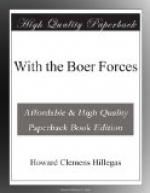The beginning of the second day’s journey was characterised by a ride up and along the sides of a magnificent gorge through which the waters of the Crocodile River rushed from the lofty plateau of the high veld to the wildernesses of the fever country and filled that miniature South African Switzerland with myriads of rainbows. A long, curved, and inclined tunnel near the top of the mountain led to the undulating plains of the Transvaal—a marvellously rapid transition from a region filled with nature’s wildest panoramas to one that contained not even a tree or rock or cliff to relieve the monotony of the landscape. On the one side of this natural boundary line was an immense territory every square mile of which contained mountain passes which a handful of Boers could hold against an invading army; on the other side there was hardly a rock behind which a burgher rifleman could conceal himself. Here herds of cattle and flocks of sheep, instead of wild beasts, sped away from the roar of the train; here there was the daub and wattle cottage of the farmer instead of the thatched hut of the native savage.
Small towns of corrugated iron and mud-brick homes and shops appeared at long intervals on the veld; grass-fires displayed the presence of the Boer farmer with his herds, and the long ox-teams slowly rolling over the plain signified that not all the peaceful pursuits of a small people at war with a great nation had been abandoned. The coal-mines at Belfast, with their towering stacks and clouds of smoke, gave the first evidence of the country’s wondrous underground wealth, and then farther on in the journey came the small city of Middleburg with its slate-coloured corrugated iron roofs in marked contrast to the green veld grass surrounding it. There appeared armed and bandoliered Boers, prepared to join their countrymen in the field, with wounded friends and sad-faced women to bid farewell to them. While the train lay waiting at the station small commandos of burghers came dashing through the dusty streets, bustled their horses into trucks at the rear end of the passenger train, and in a few moments they were mingling with the foreign volunteers in the coaches. Grey-haired Boers gravely bade adieu to their wives and children, lovers embraced their weeping sweethearts, and the train moved on toward Pretoria and the battlefields where these men were to risk their lives for the life of their country.
Historic ground, where Briton and Boer had fought before, came in view. Bronkhorst Spruit, where a British commander led more than one hundred of his men to death in 1880, lay to the left of the road in a little wooded ravine. Farther on toward Pretoria appeared rocky kopjes, where afterwards the Boers, retreating from the capital city, gathered their disheartened forces, and resisted the advance of the enemy. Eerste Fabriken was a hamlet hardly large enough to make an impression upon the memory, but it marked a battlefield where the burghers fought desperately.




